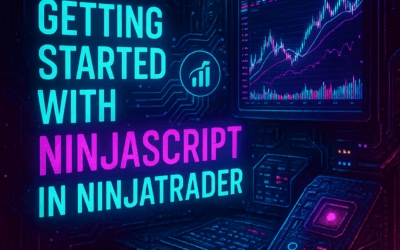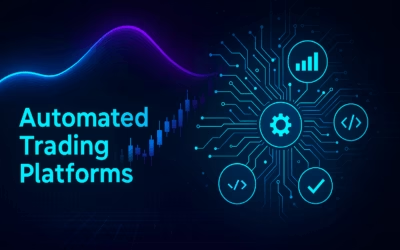Order Flow Trading with NinjaTrader: A Practical Guide to Volume and Price Action
Technical analysis has long been the backbone of trading decisions, but in today’s highly competitive futures markets it is no longer enough to simply react to price patterns. Traders who succeed consistently look deeper—into the actual flow of buying and selling orders that move the market. This is where Order Flow Trading with NinjaTrader becomes a powerful edge.
Introduction ·
What is Order Flow? ·
NinjaTrader Order Flow Tools ·
Why Use Order Flow? ·
Practical Applications ·
Best Practices ·
FAQ
Introduction
Traditional chart analysis is useful, but it often lags behind real market activity. By the time a moving average crossover or oscillator divergence appears, much of the move may already be underway. Order flow analysis, on the other hand, gives traders a real-time look at the aggressiveness of buyers and sellers.
It answers questions like: Who is pushing the market? Are buyers absorbing heavy sell pressure, or are sellers overwhelming the bid? These insights allow traders to align with institutional behavior rather than chasing lagging signals. In fast-moving futures markets like the S&P 500 or Crude Oil, this transparency can mean the difference between catching the move early and entering after the opportunity is gone.
NinjaTrader’s Order Flow + tools transform raw market data into visual maps of supply and demand. Instead of staring at endless streams of prints on the time and sales, you can see areas of absorption, exhaustion, and imbalances directly on your charts. With practice, order flow trading helps traders anticipate turning points, confirm breakouts, and avoid false signals that catch less-informed traders off guard.
What is Order Flow?
Order flow is the study of how market orders—buys and sells—are executed. Every trade leaves behind a footprint, showing not just price, but who traded at the bid and who traded at the ask. By analyzing these footprints, traders can identify whether demand or supply is in control at any given moment.
For example, if the market is rising but the majority of trades are hitting the bid, it may indicate hidden selling pressure that could stall the move. Conversely, if prices are holding steady while aggressive buyers keep lifting the offer, it signals strong demand that could fuel a breakout.
Unlike standard indicators that use delayed averages, order flow provides transparency into live market conditions. This transparency allows traders to align with institutional activity rather than guessing based on historical patterns. Instead of reacting after the fact, you’re reading the market’s “conversation” as it happens.
NinjaTrader Order Flow Tools
NinjaTrader’s Order Flow + suite includes several advanced tools designed for professional-level analysis. Each tool gives you a different perspective on the market:
- Delta Suite for NinjaTrader: A comprehensive package for tracking delta-based order flow. It combines heatmaps, cumulative delta, and divergence detection to reveal the balance of buying and selling pressure.
- Volumetric Bars: Provide detailed bid/ask activity inside each candle. They help traders spot absorption (buyers holding the line against heavy selling), exhaustion (buyers or sellers running out of steam), and imbalances (one side aggressively dominating).
- Delta Bars: A cleaner, visual way to see the shift in order flow bar by bar. Instead of relying only on price, you get a precise read on who’s in control during each candle.
- Volume Profile: Reveals where the most trading activity has taken place at specific price levels. High-volume nodes often act as support and resistance, while low-volume areas highlight potential breakout zones.
- VWAP (Volume Weighted Average Price): A benchmark used by institutions to assess fair value. Price tends to revert to VWAP in ranging markets, but strong trends often ride VWAP as dynamic support or resistance.
- Cumulative Delta: Tracks the net difference between buying and selling pressure over time. If price makes new highs but cumulative delta fails to confirm, it may signal weakening demand and a potential reversal.
- Market Depth Map: Displays resting limit orders in the order book. Large liquidity clusters can act like magnets or walls, while sudden order removals may foreshadow sharp moves.
By combining these tools, traders can create a layered view of market activity that goes far beyond traditional candlestick charts.
Why Use Order Flow?
Order flow trading offers distinct advantages over traditional technical analysis:
| Benefit | Why It Matters |
|---|---|
| Transparency | Reveals the actual battle between buyers and sellers, not just price outcomes. |
| Precision | Pinpoints entries and exits based on real activity rather than delayed signals. |
| Early Signals | Identifies shifts in market control before moving averages or oscillators catch up. |
| Context | Shows when institutions are stepping in, providing critical clues to future direction. |
| Confidence | Traders who understand order flow often stick to their setups with greater conviction. |
Simply put: order flow reduces uncertainty by showing what’s really happening behind the price action.
Practical Applications
Here are some common ways traders use order flow tools in NinjaTrader, with examples:
- Breakout Confirmation: Imagine the E-mini S&P trading in a 10-point range. When price pushes above resistance, you check cumulative delta (or the Delta Suite). If aggressive buying is surging, the breakout is likely genuine. If delta lags, it could be a trap.
- Reversal Detection: Gold futures push to new highs, but Volumetric Bars reveal sellers absorbing contracts at each tick higher. Price stalls, then reverses. Order flow gave the clue before the chart did.
- VWAP Mean Reversion: Crude oil futures trade far above VWAP during the morning session. As volume fades, traders look for shorts back to VWAP. When Delta Bars turn negative near the highs, it adds confirmation to fade the move.
- Scalping Around Liquidity: Nasdaq futures show a large bid cluster at 15,200. A scalper enters long just above it, targeting a 5–10 point bounce. When the depth map shows those bids pulled, the scalper exits quickly.
- Institutional Tracking: Watching the Market Depth Map on the S&P reveals iceberg orders (hidden large orders split into smaller ones). Recognizing this behavior keeps retail traders from being caught off guard.
Best Practices
Order flow is powerful, but it requires discipline. Follow these best practices:
- Simplify: Start with one or two tools (such as Volume Profile and Cumulative Delta) before layering on more complexity.
- Confirm, Don’t Predict: Use order flow to confirm setups, not to chase every flicker of the tape.
- Align Timeframes: Check higher timeframe context to avoid fading strong trends with short-term signals.
- Clean Charts: Clutter kills clarity. Focus on the most relevant tools.
- Risk Management: Even the best order flow signals fail. Always use stops and manage position size.
- Review and Learn: Record your trades and analyze how order flow behaved at turning points.
Consistency comes from combining order flow insights with sound trading discipline.
FAQ
Is order flow suitable for beginners? Yes, but expect a learning curve. Begin with Volume Profile before advancing to Volumetric Bars.
Do I need special data feeds? Yes. Full order flow requires Level II data with bid/ask detail.
Which markets are best for order flow? Futures like the S&P 500 (ES), Nasdaq (NQ), Crude Oil (CL), and Gold (GC) due to their liquidity and transparency.
Can order flow be automated? Yes. NinjaScript allows coders to incorporate order flow signals into automated strategies.
Does order flow replace technical indicators? Not necessarily. Many traders combine both for context and confirmation.
How long does it take to learn? Most traders need weeks to grasp basics and months of practice to feel comfortable reading order flow in real time.
Is order flow useful for swing trading? Yes. While often applied intraday, order flow can confirm swing entries around major levels.
What’s the biggest mistake beginners make? Overloading charts with too many tools and signals. Less is more.



0 Comments